阿根廷¶
网络研讨会¶
您可以在此找到有关本地化的一般说明以及如何进行配置的视频。
另请参见
配置¶
模块安装¶
安装 以下模块以获得阿根廷本地化的所有功能:
名称 |
技术名称 |
描述 |
|---|---|---|
阿根廷 - 会计 |
|
默认的 财政本地化包,它表示在 AFIP 规定和指南下在阿根廷运营的最低配置。 |
阿根廷会计报告 |
|
增值税账簿报告和增值税汇总报告。 |
阿根廷电子发票 |
|
通过 Web 服务生成电子发票的所有技术和功能要求,基于 AFIP 规定。 |
|
(可选)允许用户在电子商务结账表单中查看证件类型和AFIP责任,以便创建电子发票。 |
配置您的公司¶
在安装完本地化模块后,第一步是设置公司的数据。除了基本信息外,需要填写的一个关键字段是:AFIP 责任类型,该字段表示公司的税务义务和结构。

会计科目表¶
在会计中,有三种不同的 会计科目表 供选择。它们是根据公司的 AFIP 责任类型来确定的,并考虑到那些不需要太多账户的公司与那些具有更复杂税务要求的公司之间的差异:
小规模纳税人(227个账户);
免税增值税(290 账户);
已注册负责人(298 账户)

配置主数据¶
电子发票凭证¶
环境¶
AFIP 基础架构在两个独立的环境中进行复制,测试 和 生产。
测试功能的提供使得公司可以在准备好迁移到**生产**环境之前对其数据库进行测试。由于这两个环境彼此完全隔离,一个实例的数字证书在另一个实例中无效。
要选择数据库环境,请转到 ,并选择 测试 (Testing) 或 生产 (Production)。

AFIP 证书¶
电子发票和其他 AFIP 服务使用由 AFIP 提供的 Web 服务 (WS)。
为了能够与 AFIP 进行沟通,第一步是如果尚未拥有,则请求一个 数字证书。
业务伙伴¶
证件类型和增值税号¶
作为阿根廷本地化的一部分,AFIP 定义的文档类型现已在 业务伙伴表单 中可用。这些信息对于大多数交易至关重要。默认情况下有六种 身份类型,还有 32 种未激活的类型。

注解
已定义的 识别类型 完整列表由 AFIP 提供,并包含在 Odoo 中,但仅激活常用的几种。
应税责任类型¶
在阿根廷,文档类型以及与客户和供应商相关的交易由AFIP责任类型定义。此字段应在**业务伙伴表单**中进行设置。
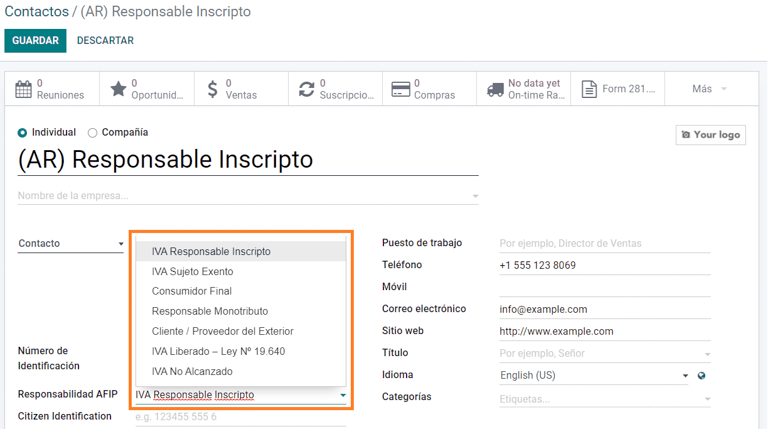
税项¶
作为本地化模块的一部分,税项会自动创建,并关联相应的财务账户和配置,例如:一般纳税人 对应的 73 种税项。

税种¶
阿根廷有多种税种,最常见的包括:
增值税: 这是常规的增值税,可以有多种税率;
税款预提: 对发票征收的税款的预付款;
留存金:对付款征收的预付税。
特殊税项¶
一些阿根廷的税种并不适用于所有公司,那些较少使用的选项在 Odoo 中默认标记为不活跃。在创建新税种之前,请确保该税种并未已被作为不活跃状态包含在内。

文档类型¶
在一些拉丁美洲国家,如阿根廷,某些会计交易(如发票和供应商账单)会根据政府税务机构定义的文档类型进行分类。在阿根廷,AFIP 是负责定义此类交易的政府税务机构。
单据类型是必须在打印报表、发票和列示会计分录的日记账中清晰显示的重要信息。
每种文档类型可以在其被分配的日记账中拥有唯一的编号序列。作为本地化的一部分,文档类型包含该文档适用的国家(此数据在安装本地化模块时会自动创建)。
此视图中默认包含 文档类型 所需的信息,因此用户无需在此处填写任何内容:

注解
有几个 文档类型 默认是停用的,但可以根据需要进行启用。
信件¶
对于阿根廷,文档类型 包含一种用于表明交易或操作类型的信件。例如,当一张发票与以下内容相关时:
B2B 交易, 必须使用文档类型 A;
B2C 交易,必须使用文档类型 B;
交易导出,必须使用文档类型 E。
已包含在本地化中的文档均已关联了相应的 文档类型,因此无需进行其他配置。

用于发票¶
每笔交易上的 单据类型 将由以下因素决定:
与发票相关的分录(如果该凭证使用了单据);
根据发行方和接收方的类型应用的条件(例如,买方的税务制度类型和供应商的税务制度类型)。
凭证类型¶
在阿根廷本地化设置中,根据其用途和内部类型,日记账可能会有不同的处理方式。要配置日记账,请转至:。
对于销售和采购日记账,可以启用选项 使用文档,这将启用一组可以与发票和供应商发票关联的 文档类型。有关发票的更多详细信息,请参阅章节 2.3 文档类型。
如果销售或采购日记账未激活 使用文件 选项,则无法生成财政发票,也就是说,其使用场景将主要局限于监控与内部控制流程相关的会计分录。
AFIP 信息(也称为 AFIP 销售点)¶
AFIP POS 系统 是一个仅在 销售 日记账中可见的字段,用于定义在创建该日记账时将用于管理相关交易的 AFIP POS 类型。
AFIP POS 定义如下:
相关网页服务的文档类型序列;
电子发票文件的结构和数据。

Web 服务¶
Web 服务 可用于生成不同用途的发票。以下是几个可选选项:
wsfev1: 电子发票: 是最常用的业务,用于生成 A、B、C、M 类型的文档发票,且不按项目明细开具。
wsbfev1:电子财政债券: 适用于那些开具资本商品发票并希望享受经济部颁发的电子税务债券优惠的用户。了解更多详情,请访问:财政债券;
wsfexv1:电子出口发票:用于为国际客户和涉及出口流程的交易生成发票,相关文档类型为“E”类型。

以下是使用 Web 服务时一些有用的字段:
AFIP 销售点编号:是在 AFIP 中配置的用于标识与此 AFIP 销售点相关的操作的编号;
AFIP POS 地址: 是与POS机注册的商业地址相关的字段,通常与公司地址相同。例如,如果一家公司有多个门店(税务地点),则AFIP要求公司在每个地点都设置一个AFIP POS。该地点将在发票报告中打印;
统一账簿: 当 AFIP POS 系统为 Preimpresa 时,具有相同字母的单据类型(适用于该日记账)将共享相同的编号序列。例如:
发票:FA-A 0001-00000002;
贷项通知单:NC-A 0001-00000003;
借方凭证:ND-A 0001-00000004。
序列¶
对于第一张发票,Odoo 会自动与 AFIP 同步,并显示最后一次使用的编号序列。
注解
在创建 采购日记账 时,可以定义它们是否与单据类型相关。如果选择了使用单据的选项,则无需手动关联单据类型的序列号,因为单据编号由供应商提供。
使用和测试¶
发票¶
以下信息适用于在创建并正确配置了合作伙伴和账簿之后的发票创建过程。
文档类型分配¶
当选择业务伙伴时,文档类型 字段将根据 AFIP 文档类型自动填写:
针对 IVA 责任人注册客户的发票,前缀为 A 是一种详细列出所有税项及客户信息的文件。

面向最终客户的发票,前缀为 B 是一种不详细列出税额的文档,因为税额已包含在总金额中。

出口发票(前缀为 E) 是在出口货物时使用的文件类型,用于显示贸易术语。

尽管某些发票使用相同的账簿,但前缀和序号由 文档类型 字段决定。
最常见的 单据类型 将根据 AFIP 责任类型的不同组合自动定义,但用户可以在确认发票前手动进行更新。
电子发票要素¶
在使用电子发票时,如果所有信息都正确,发票将按照标准方式发布,除非出现需要处理的错误。当出现错误提示时,会同时显示需要关注的问题及建议的解决方案。如果错误持续存在,发票将保持为草稿状态,直到问题得到解决。
一旦发票被过账,与AFIP验证和状态相关的信息将在AFIP选项卡中显示,包括:
AFIP 许可: CAE 编号;
到期日期: 向客户提交发票的截止日期(通常为生成CAE后的10天内);
结果: 表示发票是否已 在AFIP中被接受 和/或 被接受但有备注。

发票税项¶
根据 AFIP 责任类型,增值税税款在 PDF 报告中的应用方式可能有所不同:
A. 税前金额: 在这种情况下,报表中需要明确标识含税金额。此条件适用于客户具有以下 AFIP 责任类型 登记纳税人 的情况;

B. 税额包含在内:这意味着含税金额已作为产品价格、小计和总计的一部分。此条件适用于客户具有以下AFIP责任类型时:
免税应税人;
最终消费者;
所得税负责人;
已释放的增值税。

特殊使用案例¶
服务发票¶
对于包含 服务 的电子发票,AFIP 要求报告服务的起始和结束日期,此信息可以在标签页 其他信息 中填写。
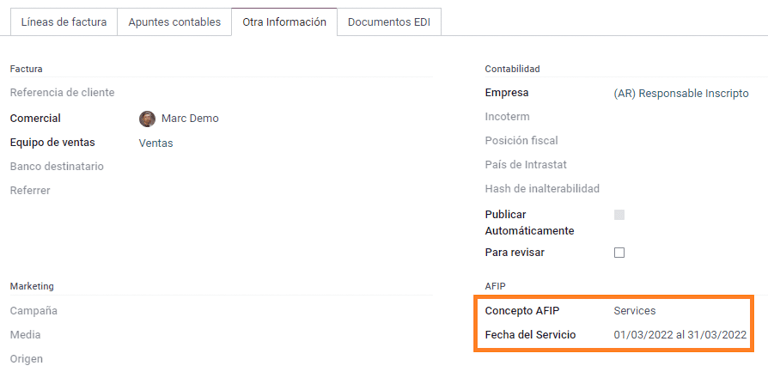
如果在发票审核前未手动选择日期,系统将自动使用发票所属月份的第一天和最后一天填充这些值。

导出发票¶
与 出口交易 相关的发票需要使用 AFIP POS 系统 Expo 电子凭证 - 网络服务 的账簿,以便关联正确的单据类型。

当发票中选择的客户配置了 AFIP 责任类型:境外客户 / 供应商 - 第19.640号法律 时,Odoo 会自动分配以下内容:
与出口WebService相关的日记账;
文档类型导出;
财务位置:国外采购/销售;
概念 AFIP:产品 / 货物的最终出口;
免税税项。

注解
导出文档需要启用并配置贸易术语(Incoterms),可以在 中找到。

财政债券¶
The Electronic Fiscal Bond is used for those who invoice capital goods and wish to access the benefit of the Electronic Tax Bonds granted by the Ministry of Economy.
对于这些交易,需要注意以下要求:
货币(根据参数表)及发票报价;
税项;
区域;
详细列出每项内容;
根据南方共同市场通用分类编码(NCM)进行编码;
完整描述;
净单价;
数量;
计量单位;
奖金;
增值税率。
电子信用发票(MiPyme,FCE)¶
对于中小企业发票,有几种文档类型被归类为 MiPyME,也被称为 电子信用发票**(或西班牙语中的 **FCE)。这种分类建立了一种机制,有助于改善中小企业的融资条件,并通过提前收回应收账款和客户及/或供应商开具的票据来提高其生产力。
对于这些交易,需要注意以下要求:
特定文档类型(201、202、206 等);
发射方应符合 AFIP 对 MiPyME 交易的资格要求;
金额应大于 100,000 ARS;
必须将银行账户类型 CBU 与发件人相关联,否则发票无法验证,并会出现如下错误信息。

要设置 传输模式,请进入设置并选择 SDC 或 ADC。
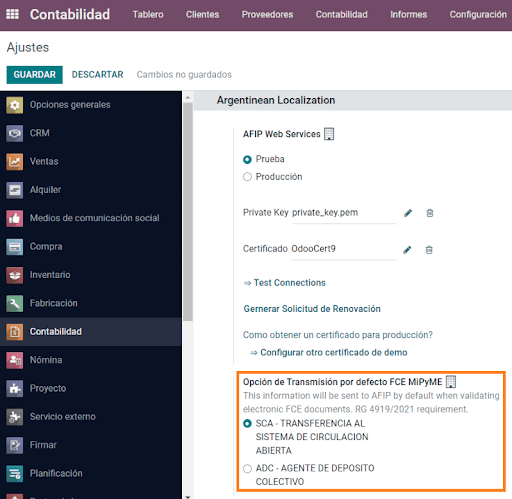
要更改特定发票的 传输模式,请转到 其他信息 选项卡,并在确认前进行修改。
注解
更改 传输模式 不会更改 设置 中所选的模式。

在创建与FCE文档相关的 贷项/借项 通知时:
使用 贷项和借项通知单 按钮,以便将发票的所有信息传递到新的 贷项和借项通知单 中;
该文档的格式应与原始文档(A 或 B)相同;
必须使用与源单据相同的货币。在使用辅助货币时,如果开票日和付款日的汇率不同,就会产生汇兑差额。可以创建贷方/借方通知单来减少/增加应付的阿根廷比索(ARS)金额。

在创建 贷项通知单 时,我们可能会遇到两种情况:
由于 FCE 被拒绝,因此 贷项通知单 应该将字段 FCE,是否为取消? 设置为 True;或者;
该 贷方凭证 用于冲销 FCE 文档,在此情况下,字段 FCE, 是否为冲销? 必须为 *空*(false)。

发票打印报表¶
该 PDF 报表 是与已通过 AFIP 验证的电子发票相关,报表底部包含一个条形码,用于表示 CAE 编号。由于是法律要求,到期日期也会显示在报表上。

故障排除与审计¶
为了审计和故障排查的目的,可以获取之前已发送至阿根廷税务局(AFIP)的发票编号的详细信息。要检索此信息,请启用 开发者模式,然后进入 菜单,并在 AFIP 中点击 查询发票 按钮。

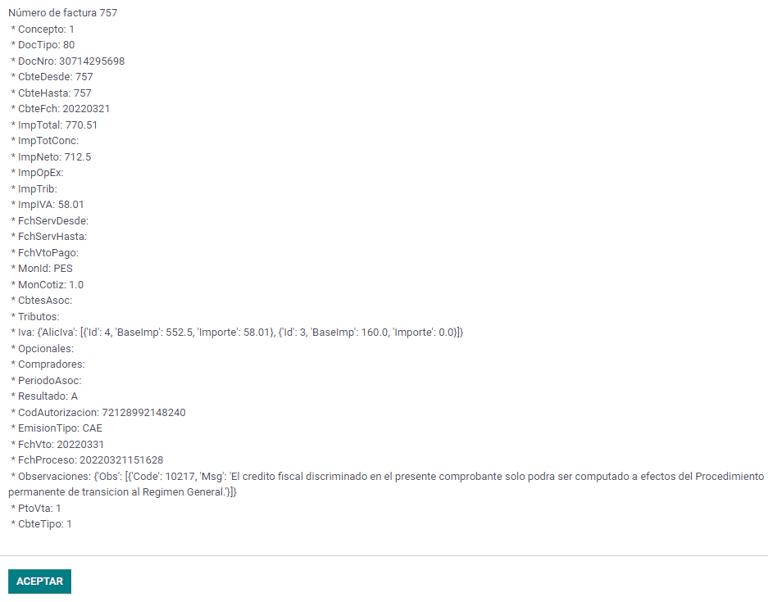
也可以检索特定单据类型和POS编号在AFIP中使用的最后一个号码,作为Odoo与AFIP之间序列同步可能出现问题的参考。

供应商发票¶
根据所选供应商发票的采购日记账,单据类型 现为必填字段。此值会根据开票方和客户的 AFIP 责任类型自动填充,但如需更改,也可以进行修改。

guilabel:文档编号 字段需要手动填写,格式将自动验证。然而,如果格式无效,将会显示用户错误信息,提示预期的正确格式。

供应商发票编号的结构与客户发票相同,只是文档序列由用户按照以下格式输入:文档前缀 - 字母 - 文档编号。
验证供应商发票编号(AFIP)¶
由于大多数公司都有内部控制机制,用于验证供应商发票是否与有效的 AFIP 文件相关联,可以在 中设置自动验证,具体包括以下级别:
不可用: 验证未执行(这是默认值);
可用: 验证已完成。如果号码无效,只会显示警告信息,但仍允许供应商发票过账;
必需的: 验证已完成,如果单据编号无效,则不允许用户提交供应商发票。

在 Odoo 中验证供应商发票¶
在启用供应商验证设置后,Odoo 中的供应商发票上会显示一个新按钮,标记为 在 AFIP 上验证,该按钮位于 AFIP 授权代码 字段旁边。

如果供应商发票无法在AFIP中验证,仪表盘上将显示 已拒绝 的状态,并且无效详情将添加到聊天记录中。

特殊使用案例¶
未计税项目¶
有些交易包含不属于增值税计税基础金额的项目,例如燃油和汽油发票。
供应商发票将通过每个属于增值税计税基础金额的产品项进行登记,并另设一项用于登记免税项目的金额。

感知税¶
供应商发票将根据属于增值税计税基础的每个产品分别登记一项,而感知税可以添加到任意一个产品行中。因此,将为增值税设置一个税组,为感知税设置另一个税组。感知税的默认值始终为:0.10。
要编辑增值税预提并设置正确金额,请使用位于 预提 金额旁边的 铅笔 图标。在设置好增值税预提金额后,即可对发票进行验证。

检查管理¶
要安装 第三方及延期/电子支票管理 模块,请转到 ,并通过其技术名称 l10n_latam_check 搜索该模块,然后点击 激活 按钮。

此模块用于配置凭证和付款所需的设置,以实现:
创建、管理和控制您不同类型的支票
优化*自有支票*和*第三方支票*的管理
从您自己的和第三方支票中轻松有效地管理到期日期
在完成阿根廷电子发票流程的所有配置后,还需要为自有支票和第三方支票流程完成某些配置。
自己的检查¶
通过进入 ,选择银行日记账,并打开 对外付款 选项卡,配置用于创建您自己支票的银行日记账。
支票 应该作为 付款方式 可用。如果不可用,请点击 添加一行,并在 付款方式 下输入
Checks以添加它们。启用 使用电子和延期支票 设置。
注解
此最后配置 禁用 打印功能,但可启用以下功能:
手动输入支票号码
添加一个字段,用于分配支票的付款日期

自己的支票管理¶
可以直接从供应商发票创建自己的支票。为此,请点击 注册付款 按钮。
在付款登记弹窗中,选择要进行付款的银行账簿,并设置 现金存入日期 和 金额。

注解
要管理当前支票,必须将 支票入账日期 字段留空或填写当前日期。要管理延期支票,必须将 支票入账日期 设置为未来日期。
要管理您现有的自定义支票,请导航至:。此窗口显示关键信息,例如支票需要支付的日期、支票的总数量以及通过支票支付的总金额。

需要注意的是,列表中已预先过滤了尚未与银行对账单 核对 的支票——即尚未从银行扣除的支票,可以通过 是否与银行对账单匹配 字段进行验证。如果您想查看所有自己的支票,请点击 X 符号以删除 无银行对账 过滤条件。

取消一张自己的支票¶
要取消在 Odoo 中创建的自有支票,请导航至:,然后选择要取消的支票,点击 作废支票 按钮。这将解除与供应商账单和银行对账单的勾对,并将支票状态设为 已取消。

第三方支票¶
为了使用第三方支票进行付款登记,需要配置两个特定的日记账。为此,请导航至 并创建两个新的日记账:
Third Party Checks已拒绝的第三方支票
注解
您可以根据需要为多个销售点手动创建更多账簿。
要创建*第三方支票*科目表,请点击 新建 按钮并进行以下配置:
Type
Third Party Checksas the Journal Name选择 现金 作为 类型
在 日记账条目 选项卡中,将 现金科目 设置为
1.1.1.02.010 第三方支票,输入您选择的 简称,并选择一个 货币。
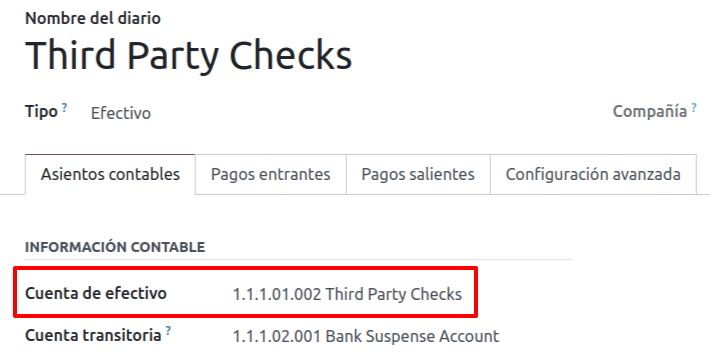
可用的付款方式列在“付款”选项卡中:
对于新的第三方支票,进入 ,并选择 新建第三方支票。此方法用于创建 新的 第三方支票。
对于现有的第三方支票的收入和支出,进入 ,并选择 现有第三方支票。在 支出付款 标签中重复相同的操作。此方法用于通过已*存在*的支票来收取和/或支付供应商账单,以及用于内部转账。
小技巧
您可以删除在配置第三方支票账簿时默认显示的现有付款方式。

被拒第三方支票 科目也需要创建和/或配置。该科目用于管理被拒的第三方支票,可用于处理在收款时被拒的支票,或来自供应商且被拒的支票。
要创建 被拒第三方支票 日记账,请点击 新建 按钮并进行以下配置:
Type
Rejected Third Party Checksas the Journal Name选择 现金 作为 类型
在 日记账条目 选项卡中,将 现金科目 设置为
1.1.1.01.002 被拒第三方支票,输入您选择的 简码,并选择一个 货币。
使用与“第三方支票”日记账相同的付款方式。
新的第三方支票¶
要为客户的发票登记一张*新的*第三方支票,请点击 登记付款 按钮。在弹出窗口中,您必须选择 第三方支票 作为付款登记的日记账。
选择 第三方支票 作为 付款方式,并填写 支票号码、付款日期 和 支票银行。可选地,您可以手动添加 支票出票人税号,但该字段会根据与发票相关的客户税号自动填充。

现有的第三方支票¶
要使用*现有的*支票支付供应商账单,请点击 注册付款 按钮。在弹出窗口中,您必须选择 第三方支票 作为付款登记的账簿。
选择 现有第三方支票 作为 付款方式,并从 支票 字段中选择一张支票。该字段显示所有 可用的现有支票,可用于供应商账单的付款。

当使用**现有的第三方支票**时,您可以查看与之相关的操作。例如,您可以查看一张用于支付客户发票的第三方支票是否后来被用作现有的第三方支票以支付供应商账单。
要执行此操作,请前往: 或 ,具体取决于情况,然后点击一张支票。在 当前日记账 字段中,点击 => 支票操作 以查看支票的历史记录和变动情况。

菜单还显示与这些操作相关的关键信息,例如:
付款类型,用于分类该笔付款是*发送*给供应商的付款,还是*接收*自客户的付款。
当前支票所登记的 日记账
该操作相关的**业务伙伴**(客户或供应商)。
电子商务电子发票¶
安装 阿根廷电商 (l10n_ar_website_sale) 模块,以启用以下功能和配置:
客户能够在线创建用于电子商务的账户。
电子商务应用中对必填财政字段的支持。
在线接收销售订单的付款。
从电子商务应用程序生成电子文档。
配置¶
在完成阿根廷 电子发票 流程的所有配置后,还需要完成一些配置以集成电子商务流程。
客户账户注册¶
要为客户账户配置您的网站,请按照 结账 文档中的说明进行操作。
自动生成发票¶
通过导航至 来配置您的网站,在 开票 部分中启用 自动开票 功能,以便在在线付款确认时自动生成所需的电子文档。

由于生成 自动发票 功能所需的在线付款需要确认,因此必须为相关网站配置 支付提供商。
产品¶
为了使您的产品在在线付款确认后能够被开票,请导航至: 中的所需产品。在 通用信息 选项卡中,将 开票策略 设置为 订购数量,并定义所需的 客户税项。
电子商务的开票流程¶
在完成上述所有配置后,客户可以在 阿根廷电子商务 流程中完成以下必填步骤,以在结账过程中输入财政字段。
一旦将 国家 字段设置为 阿根廷,财务字段将在结账过程中可供输入。输入财务数据可使采购在相应的电子文件中完成。

当客户完成成功的采购和付款后,将根据 发票打印报告 中所述的相应格式和财政印章生成必要的发票。
另请参见
流动性产品直销¶
流动性产品直销用于涉及第三方的销售。对于此类销售,卖家和货物所属公司可以分别注册其对应的销售和采购。
注解
安装 阿根廷电子发票 模块 (l10n_ar_edi) 以使用此功能。
配置¶
采购日记账¶
需要一个采购日记账来生成带有文档类型 流动性产品 的电子供应商账单。该日记账需要与 AFIP 进行同步,因为它将用于生成流动性产品的电子文件。
要修改现有的采购日记账或创建一个新的,请导航至:。然后,选择现有的采购日记账或点击 新建 按钮,并填写以下必填信息:
类型: 选择 采购。
使用文档:勾选此字段以选择电子文档类型。
是否为 AFIP POS:勾选此字段以生成电子文件。
AFIP POS 系统:从下拉菜单中选择 电子发票 - 网络服务,以便通过网络服务将电子文档发送至 AFIP。
AFIP 点钞机编号: 是在 AFIP 中配置的用于标识与此 AFIP 点钞机相关的操作的编号。
AFIP POS 地址: 是与POS机注册的营业地址相关的字段,通常与公司地址相同。例如,如果一家公司有多个门店(税务地点),则AFIP要求公司在每个地点都设置一个AFIP POS。该地点将在发票报告中打印。

销售日记账¶
当将产品销售给第三方,而该第三方随后会再销售同一产品时,需要使用销售日记账来登记发票。此日记账不会与AFIP同步,因为该发票不是电子发票。
要修改现有的销售日记账或创建一个新的,请导航至:。然后,选择销售日记账或点击 新建 按钮,并填写以下必填信息:
类型: 选择 销售。
使用文档:在科目表中勾选此字段以选择电子文档类型(在此情况下为电子发票)。

发票流程¶
一旦所有配置完成,由代表另一方销售产品的公司生成 流动性产品供应商发票。例如,某个特定产品的经销商。
报表¶
作为本地化安装的一部分,阿根廷的财务报告可在 会计 仪表板中使用。要访问这些报表,请导航至 。
要访问增值税账簿报告,请转到 ,点击 (账簿),然后选择 阿根廷增值税账簿 (AR)。
注解
增值税申报表可以通过在左上角下拉菜单中选择它,导出为 .zip 文件。
增值税汇总¶
此透视表用于检查月度增值税总额。该报表仅供内部使用,不会发送给AFIP。
IIBB - 按司法管辖区销售¶
此透视表允许您验证每个司法管辖区的总收入。它作为相应应缴税款的证明文件,但不提交给AFIP。

IIBB - 按司法管辖区采购¶
此透视表允许您验证每个司法管辖区的毛采购额。它作为相应应缴税款的宣誓书,但不提交给AFIP。



